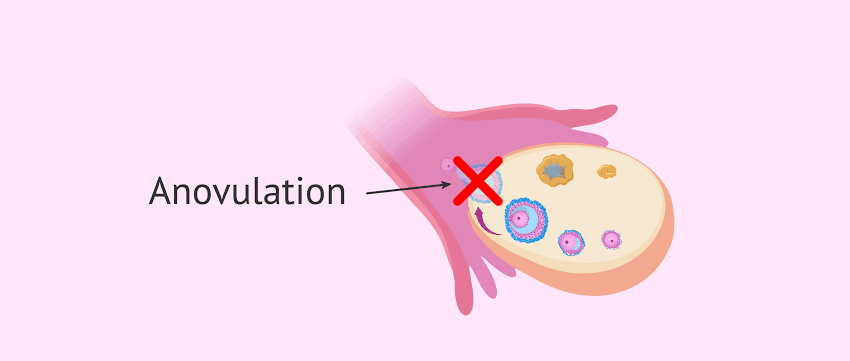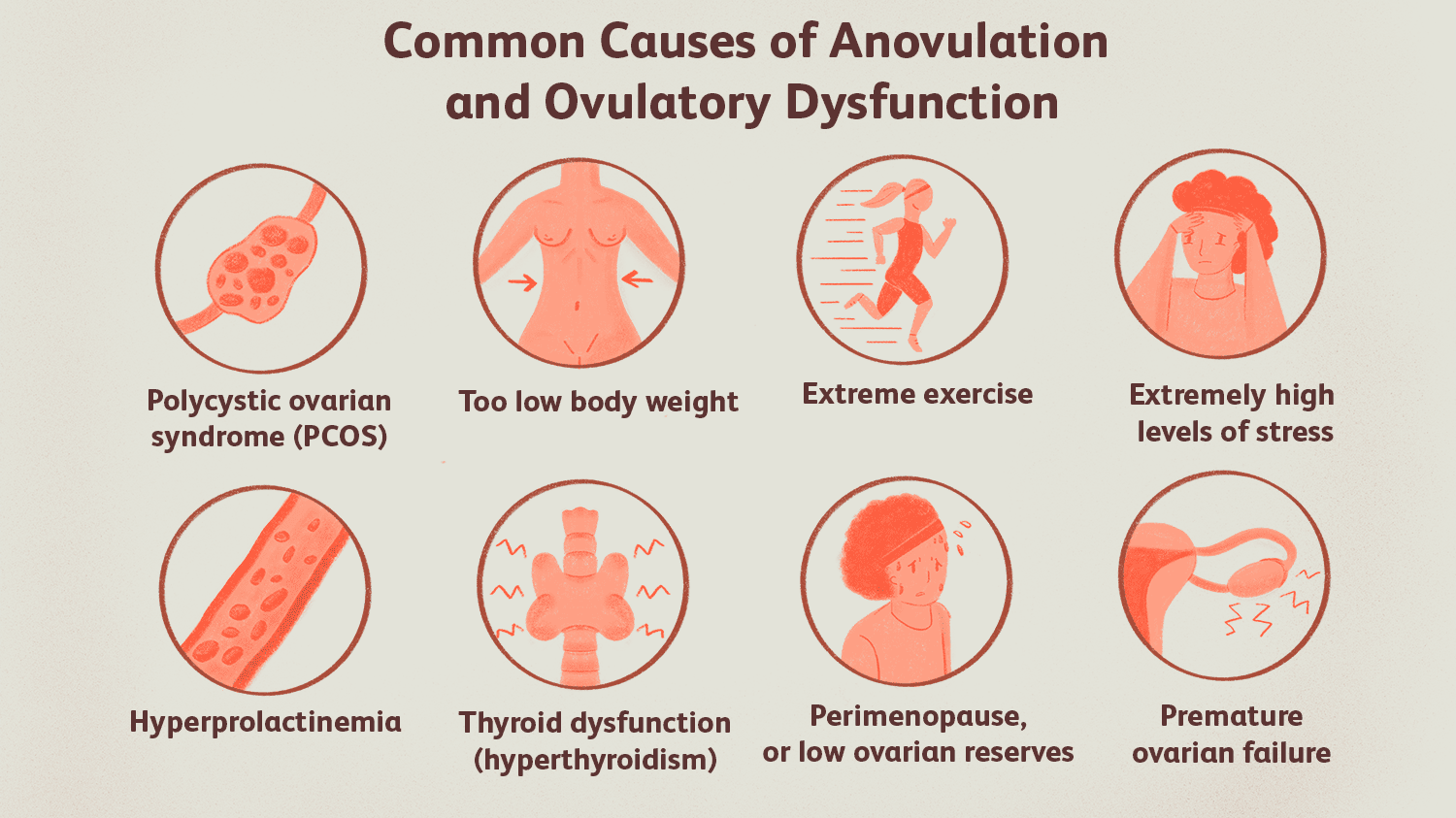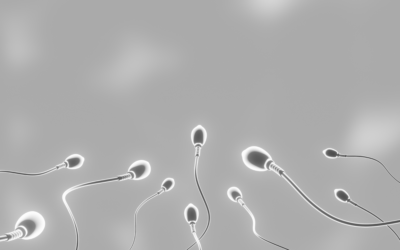
Ovulation is the release of an egg from the ovary. It must occur for pregnancy to be achieved
naturally. Anovulation means a lack of ovulation or absent ovulation. When ovulation is irregular—
but not completely absent—it is called oligo-ovulation.
Both anovulation and oligo-ovulation are types of ovulatory dysfunction. Ovulatory dysfunction is a
common cause of female infertility. Up to 40% of infertile people with ovaries experience
dysfunctional ovulation.
Anovulation and Infertility
When a couple is not experiencing infertility, the chances of conception are about 25% each month.
However, even when ovulation happens normally, a couple is not guaranteed to conceive.
When a person is anovulatory, they cannot get pregnant because there is no egg to be fertilized. If a
person has irregular ovulation, they will have fewer chances to conceive because they ovulate less
frequently.
Late ovulation does not produce the best quality eggs, which can also make fertilization less likely.
Additionally, irregular ovulation usually indicates there is something off about a person’s hormone
levels. Hormonal irregularities can lead to other health issues, including:
- Abnormally low levels of progesterone
- Lack of fertile cervical mucus
- Shorter luteal phase
- Thinning or over-thickening of the endometrium (the lining of the uterus where a fertilized egg needs to implant) very heavy or very light periods
Symptoms
People with anovulation usually have irregular periods.2 Some do not get their cycles at all.
If your cycles are shorter than 21 days, or longer than 36 days, you may have ovulatory dysfunction.
If your cycles fall within the normal range of 21 to 36 days, but the length of your cycles varies
widely from month to month, that could also be a sign of ovulatory dysfunction. For example, if
one month your period is 22 days and the next it’s 35, the variations between cycles could signal an
ovulation problem.
While it is possible to get your menstrual cycle on an almost normal schedule and still not ovulate,
it isn’t common. A menstrual cycle where ovulation does not occur is called an anovulatory cycle.
What causes anovulation?

hormones involved in ovulation, which include:
- Gonadotropin-releasing hormone (GnRH).
- Follicle-stimulating hormone (FSH).
- Luteinizing hormone (LH).
However, even hormones that aren’t directly involved in ovulation, such as testosterone and
prolactin, can impact the hormones that are needed for ovulation. The following hormone
imbalances and conditions can cause anovulation:
High levels of androgens (hyperandrogenism): Androgens are a group of hormones that help with
growth and reproduction in both men and women. Typically, androgens are thought of as male specific hormones, but the female body produces a small amount of androgen hormones too.
Androgens include testosterone, androsterone and androstenedione. Your gonads (ovaries or
testicles) and your adrenal gland produce androgens. When a person with ovaries has a higher-than normal level of androgen hormones in their blood, it’s called hyperandrogenism. The follicles in
your ovaries contain eggs. A high level of androgens can cause these follicles to stay small instead
of enlarging and maturing like they’re supposed to before ovulation.
Conditions that can cause hyperandrogenism include:
- Polycystic ovary syndrome (PCOS)
- Obesity
- Adrenal gland issues
- Pituitary gland disorders, such as Cushing’s syndrome or acromegaly
- Certain medications, such as anabolic steroids.
Pituitary gland dysfunction (hypo gonadotrophic hypogonadism): Your pituitary gland produces luteinizing hormone (LH) and follicle-stimulating hormone (FSH), which are needed for ovulation. If your pituitary gland isn’t releasing enough LH and FSH, it can cause anovulation.
Conditions and situations that cause your pituitary gland to not release enough LH and FSH include:
- Having a very low body weight, or body mass index (BMI).
- Participating in long-term excessive or intense exercise.
- Sheehan’s syndrome.
- A pituitary gland tumor.
- Damage to your pituitary gland.
High levels of prolactin (hyperprolactinemia):
Prolactin is a hormone that’s released by your pituitary gland that’s mainly known for stimulating breast milk production (lactation). Prolactin also
suppresses luteinizing hormone (LH) and follicle-stimulating hormone (FSH), which are needed for
ovulation. Because of this, a high amount of prolactin in your blood can cause anovulation.
Conditions and situations that can cause hyperprolactinemia include:
- Breastfeeding.
- A type of pituitary gland tumor called a prolactinoma.
- Damage to your pituitary gland.
- Damage to or illness of your kidneys, liver and/or thyroid.
- Certain medications, such as psychotropic drugs, narcotics and drugs that treat ulcers or elevated levels of stomach acid.
Low levels of thyroid hormones (hypothyroidism, or underactive thyroid): Your thyroid — the butterfly-shaped gland in the front of your neck — produces two hormones that are needed for many important bodily functions: triiodothyronine (T3) and thyroxine (T4). Having a low level of thyroxine in your blood can increase the amount of prolactin your pituitary gland makes. Prolactin suppresses luteinizing hormone (LH) and follicle-stimulating hormone (FSH), which are needed for ovulation, so a low level of thyroxine can cause anovulation.
Conditions and situations that can cause hypothyroidism include:
- Hashimoto’s thyroiditis, an autoimmune disease.
- Thyroid surgery.
- Radiation therapy.
- Certain medications, such as lithium.
Low levels of gonadotropin-releasing hormone (GnRH): Your hypothalamus (a part of your brain) produces gonadotropin-releasing hormone (GnRH). GnRH triggers the release of luteinizing hormone (LH) and follicle-stimulating hormone (FSH), which are needed for ovulation. Because of this, having low levels of GnRH in your blood can cause anovulation. Damage to your hypothalamus can cause low levels of GnRH.
If you thinking you may not be ovulating please contact your GP for testing and diagnosis
Information from
https://my.clevelandclinic.org/health/diseases/21698-anovulation
https://www.verywellfamily.com/anovulation-and-ovulatory-dysfunction-1959926





0 Comments